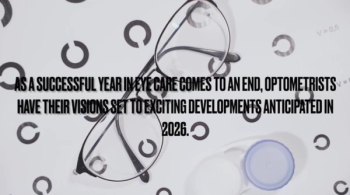
This week in optometry: June 26-June 30
Catch up on what happened in optometry during the week of June 26-June 30.
Catch up with what Optometry Times®' shared this week:
Optometry news
FDA issues CRL for aflibercept 8 mg from Regeneron Pharmaceuticals
Kassi Jackson, Editor; Sydney Crago, Editor, Modern Retina; Martin David Harp, Associate Editor, Ophthalmology Times
Regenron Pharmaceuticals announced the US Food and Drug Administration has issued a Complete Response Letter (CRL) for its aflibercept 8 mg
The company stated in a release the Biologics License Application (BLA) for aflibercept 8 mg is for the treatment of patients with wet
The CRL identified no issues with aflibercept 8 mg clinical efficacy or safety, trial design, labeling or drug substance manufacturing, and no additional clinical data or trials have been requested, Regeneron said in a press release.
The role of nutrition in myopia control
Jeffrey Anshel, OD, FAAO
Within the eyecare community, there is a predominant consensus that the cause of juvenile onset
However, the interaction of these 2 components to create refractive error remains speculative. It is becoming more apparent that myopia is not only a benign refractive error but also has long-term medical and visual consequences, yet little attention has been paid to the possible role of
Numerous studies have demonstrated that near work is related to myopia; however, all individuals in industrialized countries must do regular near work during childhood education, yet only a certain percentage of the population ultimately develops myopia.
There are several factors that have been explored as potential environmental contributors to myopia development, including the spectrum of exposed light, outdoor time, circadian rhythms, spatial frequency characteristics of written material, vitamin levels, dietary intake, physical activity, excessive near work, intraocular pressure, form deprivation, and binocular vision disorders.
We will review the role of nutrition and how it interacts with the expression of genes to create the conditions that might lead to the development of myopia.
Prevent Blindness declares June 28 to July 4 Fireworks Safety Awareness Week
David Hutton, Managing Editor, Ophthalmology Times
Prevent Blindness has declared June 28 to July 4 as the third annual Fireworks Safety Awareness Week.
According to the Consumer Product Safety Commission (CPSC), fireworks caused 9 deaths and 11,500 injuries in 2021, according to its most recent fireworks injury report. The bulk of the injuries occur between mid-June and mid-July.
“Running with sparklers, getting in the way of a bottle rocket, and fiddling around with unexploded fireworks are all just accidents waiting to happen,” Griffin Jardine, MD, an ophthalmologist at John A. Moran Eye Center, said in a news release.
TEPEZZA approved for treatment of TED in Brazil
Martin David Harp, Associate Editor, Ophthalmology Times
Horizon Therapeutics recently announced the Brazilian Health Regulatory Agency (Agência Nacional de Vigilância Sanitária - ANVISA) has approved TEPEZZA for the treatment of thyroid eye disease (TED).
This makes TEPEZZA the first and only medicine approved for treatment of TED in Brazil, according to a press release from the company.1
Vikram Karnani, executive vice president and president, global commercial operations and medical affairs, Horizon discussed the impact the medicine will have in Brazil in the press release.
Cosmetic surgery of the cornea: A new type of surgery
Jorge L. Alió, MD, PhD, FEBO
Over the past 10 years, an increasing number of studies have been conducted on the topic of keratopigmentation, that is, the induced cosmetic pigmentation change in the
This cosmetic change can be done for therapeutic purposes (eg, for corneal leukomas and blind and disfigured eyes, as well as cases with traumatic aniridia or other problems that affect the eye’s quality of vision).
The topic has been extensively studied and covered in a series of papers that have demonstrated that such techniques are effective, feasible, and very useful for patients.1-16
Visgenx announces positive results from key translational study for its gene therapy candidate for dry AMD
David Hutton, Managing Editor, Ophthalmology Times; Sydney Crago, Editor, Modern Retina
Visgenx, Inc. announced positive data from a non-human primate study of VGX-0111 to deliver the ELOVL2 transgene. The study used a single subretinal injection with the goal of investigating whether VGX-0111 expresses in the target tissues and causes an increase in very long chain polyunsaturated fatty acids at a dose that is well tolerated. VGX-0111 was able to successfully demonstrate these parameters.
While the underlying cause of dry
AOA Optometry's Meeting 2023
Optometry Times®' editorial team was on the ground in Washington, DC., bringing you the most up-to-date coverage from the 2023 American Optometric Association Optometry's Meeting.
Newsletter
Want more insights like this? Subscribe to Optometry Times and get clinical pearls and practice tips delivered straight to your inbox.













































.png)


